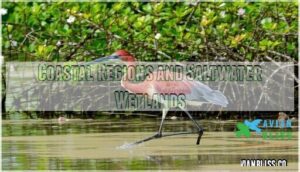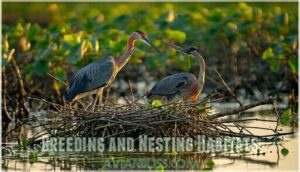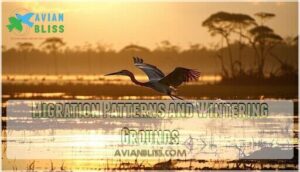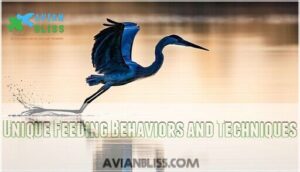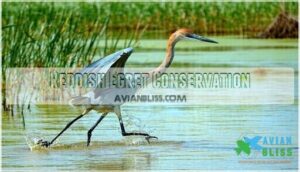This site is supported by our readers. We may earn a commission, at no cost to you, if you purchase through links.

Known for its fiery plumage and “dancing” hunting style, it uses quick, theatrical movements to outsmart fish.
Adults come in two color morphs—reddish and white—both sporting long, slender bills perfect for snatching prey.
Its legs are dark, and the pale pink bill tipped in black adds to its unique look.
These birds prefer shallow saltwater habitats, like tidal flats, where they also nest in colonies.
Once heavily hunted for their feathers, reddish egrets remain under conservation efforts today.
Curious about their quirky behaviors? Keep reading.
Table Of Contents
- Key Takeaways
- Reddish Egret Overview
- Reddish Egret Habitat
- Top 9 Reddish Egret Gifts
- 1. Cute Egret Bird Raglan Tee
- 2. Cute Wader Bird Long Sleeve Shirt
- 3. Cute Cartoon Reddish Egret Case
- 4. Reddish Egret Bird Long Sleeve Shirt
- 5. Cute Egret Bird Womens V-Neck
- 6. Birdorable Pride Rainbow Birds Baseball Tee
- 7. Cute Cartoon Reddish Egret T-Shirt
- 8. Cute Reddish Egret Morphs Sweatshirt
- 9. Birdorable Pride Rainbow Birds T-Shirt
- Reddish Egret Behavior
- Reddish Egret Conservation
- Frequently Asked Questions (FAQs)
- How rare is a reddish egret?
- Where do Reddish Egrets live?
- Why do Reddish Egrets dance?
- Are Reddish Egrets endangered?
- How rare is a Reddish Egret?
- Where are Reddish Egrets found?
- What is the difference between a red egret and a great egret?
- Where has the Reddish Egret completely disappeared?
- How do Reddish Egrets communicate with each other?
- What is the average lifespan of a Reddish Egret?
- Conclusion
Key Takeaways
- You’ll easily recognize the reddish egret by its long legs, shaggy plumage, and unique pink-and-black bill, with two distinct color morphs: dark and white.
- These rare birds thrive in shallow saltwater habitats like tidal flats and mangroves, where they use their dramatic hunting dance to outsmart fish.
- Conservation efforts have helped reddish egrets recover from near extinction caused by plume hunting, but habitat loss and climate change still pose major threats.
- By shading water with their wings and employing quick, clever movements, they display one of the most unique and efficient hunting techniques among wading birds.
Reddish Egret Overview
You’ll recognize the Reddish Egret by its long legs, slender neck, and striking pink-and-black bill, making it unmistakable among coastal birds.
With its long legs, slender neck, and striking pink-and-black bill, the Reddish Egret stands as a true coastal marvel.
This rare heron comes in two color types, dark and white, each with unique features that set it apart from other wading species.
Physical Characteristics
The reddish egret stands out with its distinctive physical traits.
It’s a long-legged, long-necked bird with unforgettable features:
- A shaggy neck and slaty-gray body in dark morphs.
- A heavy, two-toned bill: pink at the base, black at the tip.
- Dark, slender legs perfect for wading.
- Juveniles flaunt ashy copper tones, setting them apart immediately.
The key characteristics of the reddish egret, including its long-legged and long-necked features, make it a unique species.
Color Morphs and Plumage
Reddish egrets showcase two striking color morphs.
The dark morph flaunts slate-blue plumage with a reddish-brown neck, while the rarer white morph is entirely white.
Color genetics determine these variations.
Juvenile plumage differs, appearing ashy copper, unlike adults.
During breeding plumage, their shaggy feathers and bold hues stand out.
Morph rarity makes spotting these unique birds an exciting adventure for bird enthusiasts, with striking color morphs and rare sightings.
Bill and Leg Coloration
Let’s talk about bill and leg coloration—key features for spotting Reddish Egret.
Their two-toned bill shifts to sharp pink with black tips during breeding plumage.
Legs? Always dark—like a dancer in midnight stockings.
Morph differences stand out here too: white morphs keep grayish legs, while juveniles flaunt muted, copper undertones—a signature in bird morphology.
Distinctive Features of Adults and Juveniles
Adults showcase shaggy plumage, with dark morphs flaunting slate-blue bodies and reddish-brown necks, while white morphs are entirely pale.
Their striking bill coloration—pink with a black tip—sets them apart.
Juvenile plumage, a unique ashy copper, hints at their future elegance.
Compared to other herons, reddish egrets are medium-sized but unmistakable, thanks to their energetic charm and distinctive color morphs.
Reddish Egret Habitat
You’ll find the Reddish Egret thriving in warm, coastal regions where saltwater wetlands like tidal flats and mangrove swamps dominate the landscape.
This specialized habitat provides the shallow waters and rich food sources essential for their survival and breeding.
Coastal Regions and Saltwater Wetlands
When exploring saltwater wetlands, you’ll spot reddish egrets thriving in dynamic, saline-rich ecosystems.
Their favorite hangouts include mangroves, coastal tidal flats, and salt marshes, where they expertly adapt to saline conditions and bustling tidal flows.
- Mangrove importance: They provide shelter and food sources.
- Tidal flat ecosystems: Ideal grounds for active foraging.
- Salinity tolerance: Essential for surviving coastal development impacts.
Breeding and Nesting Habitats
When it’s breeding season, reddish egrets pick coastal islands with mangroves or bushes, often near tidal flats or salt marshes.
Nests are crafted together by both parents using sticks and plants.
These colonies thrive in specific habitats, influencing breeding success.
Below is a table summarizing key details:
| Aspect | Description |
|---|---|
| Colony Locations | Coastal islands with mangroves |
| Nest Construction | Sticks and plant material |
| Parental Roles | Building, incubating, and feeding |
| Breeding Success | Habitat-dependent |
| Habitat Preferences | Mangroves, tidal flats, salt marshes |
The habitat-dependent nature of their breeding and the specific choices of coastal islands with mangroves highlight the importance of environmental factors in their lifecycle.
Migration Patterns and Wintering Grounds
Beyond nesting, Reddish Egrets are wanderers of the coasts.
These coastal birds follow distinctive bird migration patterns.
- Winter Range: They stick to warm spots, like Texas and Florida.
- Coastal Movements: Habitat connectivity keeps them near shallow saltwater.
- Population Shifts: Mild winters may expand areas.
- Climate Impacts: Longer migrations could strain survival.
Top 9 Reddish Egret Gifts
If you’re looking for the perfect gift inspired by the striking reddish egret, you’ve got plenty of creative options to choose from.
From artistic apparel to unique accessories, these items capture the charm of this rare and elegant bird.
1. Cute Egret Bird Raglan Tee
If you’re searching for a gift that combines humor and bird lover pride, the Cute Egret Bird Raglan Tee fits the bill perfectly.
Featuring a whimsical cartoon of a reddish egret, this lightweight, classic-fit shirt is versatile enough for casual outings or birdwatching adventures.
The double-needle stitching guarantees durability, so it’ll last through multiple wears.
Its fun design makes it great for sparking conversations with fellow birders, and this tee celebrates nature while offering comfort and style—ideal for any bird enthusiast!
Best For: Bird enthusiasts, cartoon lovers, and anyone looking for a fun and comfortable gift for casual wear or birdwatching.
- Lightweight and comfortable for everyday use
- Durable double-needle stitching for long-lasting wear
- Whimsical cartoon design perfect for sparking conversations
- Limited color and size options available
- Material composition details not provided
- No specific customer reviews or feedback shared
2. Cute Wader Bird Long Sleeve Shirt
The Cute Wader Bird Long Sleeve Shirt is perfect for bird fans who love playful designs.
Featuring ten North American wading birds in a fun cartoon style, it includes favorites like the Reddish Egret and Great Blue Heron.
Made from lightweight, durable fabric with double-needle stitching, it’s comfortable yet sturdy.
The royal blue option adds a pop of color, ideal for casual wear or birdwatching trips.
Whether for yourself or as a gift, this shirt combines comfort and charm beautifully!
Best For: Bird enthusiasts and nature lovers looking for a comfortable, playful shirt featuring wading bird designs.
- Lightweight, durable fabric with double-needle stitching.
- Features ten North American wader species in cute cartoon style.
- Available in royal blue, perfect for casual wear or birdwatching.
- Limited to the royal blue color option.
- Only features ten specific wader species.
- May not appeal to those not interested in birds.
3. Cute Cartoon Reddish Egret Case

If you’re after a fun yet practical gift, the Cute Cartoon Reddish Egret Case blends charm and protection perfectly.
Highlighting Birdorable’s adorable design, it features the dark morph’s striking reddish neck and gray body on a durable two-part case.
Built for Samsung Galaxy S9, the scratch-resistant cover guarantees safe, stylish travels for your phone.
Fans of birdwatching will love its lightweight build and easy installation.
With a slim profile and quality construction, it’s as functional as it’s eye-catching!
Best For: Birdwatchers, cartoon lovers, and Samsung Galaxy S9 users looking for a stylish yet protective phone case.
- Only compatible with Samsung Galaxy S9.
- Limited design options specific to the Reddish Egret theme.
- Not suitable for those seeking ultra-rugged phone protection.
- Durable two-part construction for scratch and drop protection.
- Lightweight and slim design for easy portability.
- Adorable cartoon Reddish Egret design appeals to bird enthusiasts.
4. Reddish Egret Bird Long Sleeve Shirt
 View On Amazon
View On Amazon Celebrate your love for the striking Reddish Egret with this unisex long sleeve shirt.
Made from pre-shrunk 100% cotton, it’s soft, lightweight, and designed for comfort with a classic fit and durable double-needle stitching.
Available in sizes up to 6XL, it offers flexibility with a touch of style, making it perfect for birdwatching adventures or casual outings.
Machine washable and easy to care for, this shirt blends practicality with charm, making it a great gift for bird lovers everywhere.
Best For: Birdwatchers, bird lovers, and casual wearers seeking a comfortable, stylish, and durable shirt with a unique Reddish Egret design.
- Made from soft, pre-shrunk 100% cotton for comfort and durability.
- Wide size range available, including up to 6XL for flexibility in fit.
- Easy to care for with machine-washable materials.
- Slim fit may require sizing up for a more relaxed feel.
- Limited color/style options for those seeking variety.
- Cotton fabric may shrink slightly despite pre-shrunk material.
5. Cute Egret Bird Womens V-Neck
A great pick for bird enthusiasts, the Cute Egret Bird Women’s V-Neck features a lightweight and classic fit with a charming cartoon design of the iconic white morph Reddish Egret.
Made from a 50/50 cotton-polyester blend, it’s both soft and practical for everyday wear.
Whether you’re enjoying a coastal hike or meeting friends for coffee, this shirt pairs comfort with a playful nod to nature.
Machine washable and durable, it’s a fantastic gift for birdwatchers or casual nature lovers alike.
Best For: Bird lovers, nature enthusiasts, and fans of cute cartoon designs looking for a comfortable and stylish V-neck t-shirt.
- Lightweight and soft 50/50 cotton-polyester blend
- Classic fit and charming cartoon egret design
- Durable, machine washable, and easy to care for
- Limited size and color options
- No specific care instructions provided
- Lack of sustainability or ethical production details
6. Birdorable Pride Rainbow Birds Baseball Tee
The Birdorable Pride Rainbow Birds Baseball Tee is a vibrant celebration of identity and nature.
Featuring cartoon birds like the Reddish Egret against a six-color pride flag backdrop, it’s perfect for bird lovers and LGBTQ advocates.
Lightweight and cozy, this tee blends style with inclusivity, making it ideal for parades or year-round wear.
Its detailed bird designs offer a unique way to showcase your passion for wildlife and community.
A thoughtful, standout gift for LGBTQ birdwatchers everywhere!
Best For: LGBTQ bird lovers, birdwatching enthusiasts, and anyone celebrating Pride Month or showcasing inclusivity.
- Vibrant design with cartoon birds and rainbow pride theme.
- Lightweight and comfortable for parades and everyday wear.
- Unique gift idea combining birdwatching passion and LGBTQ pride.
- Limited appeal outside of birdwatching or LGBTQ communities.
- Available only through select online platforms.
- Specific bird species design may not appeal to all bird lovers.
7. Cute Cartoon Reddish Egret T-Shirt
Looking for a stylish way to showcase your love for the Reddish Egret?
This Cute Cartoon Reddish Egret T-Shirt blends comfort and charm, featuring a whimsical cartoon design of the dark morph.
Made from lightweight fine jersey fabric, it’s perfect for everyday wear.
Men should size up for a relaxed fit, while women can stick to their usual size.
The premium material guarantees durability, and the playful design makes it a conversation starter among bird enthusiasts.
Add it to your wardrobe today and enjoy the conversation starter it brings!
Best For: Bird enthusiasts who appreciate lightweight, comfortable clothing with a playful design.
- Lightweight fine jersey fabric for comfort.
- Fun cartoon design of the dark morph Reddish Egret.
- Gender-specific sizing for a better fit.
- Men’s fit runs small and requires sizing up.
- Limited to select platforms for availability.
- May not appeal to those who prefer simple or minimalist designs.
8. Cute Reddish Egret Morphs Sweatshirt
 View On Amazon
View On Amazon This sweatshirt celebrates the charm of Reddish Egrets with a cute cartoon depiction of both dark and white morphs.
Perfect for bird lovers, it blends comfort with personality, featuring a soft 8.5 oz classic fit and twill-taped neck.
The playful design highlights the species’ unique beauty and rarity, making it an excellent gift for birdwatchers, while showcasing these fascinating coastal waders with a touch of avian whimsy.
Whether you’re exploring wetlands or just relaxing at home, this durable sweatshirt adds a touch of avian whimsy to your wardrobe.
Best For: Birdwatchers, bird lovers, and wildlife enthusiasts who appreciate unique avian designs and comfortable casual wear.
- Cute design featuring both Reddish Egret morphs.
- Comfortable and durable 8.5 oz fabric with classic fit.
- Makes an excellent gift for birdwatchers and nature lovers.
- Limited to five sizes, which may not fit all body types.
- Specific to bird enthusiasts, not ideal for a general audience.
- Design may not appeal to those who prefer subtle patterns.
9. Birdorable Pride Rainbow Birds T-Shirt
For a fun way to display your love for birds and support LGBTQ inclusivity, this pride-themed shirt featuring adorable cartoon birds is perfect.
The Reddish Egret, representing orange, blends seamlessly into this vibrant rainbow lineup. It’s lightweight, fits comfortably, and radiates a message of unity.
Whether you’re attending Pride events, birdwatching, or just enjoying sunny days, this shirt emphasizes both your compassion and style.
Celebrating nature and diversity, it’s an ideal gift to showcase your values with flair and positivity.
Best For: Those who love birds, support LGBTQ inclusivity, and enjoy vibrant, lightweight apparel for Pride events or casual outings.
- Adorable cartoon bird design in rainbow colors.
- Lightweight, comfortable fit for everyday wear.
- Perfect for showcasing support for LGBTQ inclusivity.
- Limited to specific bird species in the design.
- May not suit those who prefer subtle patterns.
- Free shipping only available on orders over $99.
Reddish Egret Behavior
You’ll be amazed by the Reddish Egret’s quirky hunting style, which combines sprints, leaps, and dramatic wing flapping to chase fish.
This skilled wader uses clever tactics like shading the water with its wings to uncover prey in shallow coastal areas.
Unique Feeding Behaviors and Techniques
The reddish egret’s feeding behavior is a masterclass in agility and strategy.
Its “canopy feeding” and shadow-casting tactics turn shallow waters into dining tables.
Darting, spinning, and even leaping, this bird’s foraging dance is mesmerizing.
Through agile hunting and a shadowcasting strategy, it outsmarts prey, actively defending territories while showcasing some of the most complex hunting tactics among herons.
Primary Food Sources and Prey
Reddish Egrets are skilled fish hunters, focusing on small species like killifish, mullet, and minnows.
They adjust their bird diet based on prey availability, occasionally snapping up crustaceans and insects.
Their foraging efficiency shines with unique techniques like shading water with wings to boost hunting success.
This adaptable diet variation guarantees survival in their coastal habitats, balancing prey size and availability.
You can find a Reddish Egret shirt online.
Solitary Foraging and Territorial Behavior
When hunting solo, this bird’s foraging behavior is a spectacle. It defends its territory fiercely while employing unique tactics like a shadowcasting strategy to entice prey.
Watch for three things:
- Quick darts and zigzags showcasing its solitary lifestyle.
- Aggression displays to maintain territoriality.
- Precision strikes ensuring foraging success, one fish at a time.
Displays and Communication Methods
From bold courtship rituals to sharp agonistic displays, these birds excel in visual signals.
They toss heads, flare wings, and vocalize unique sounds during bird courtship.
Parents and chicks use soft vocalizations for communication.
Here’s a glimpse:
| Behavior | Purpose | Example |
|---|---|---|
| Visual signals | Attract mates | Wing flaring |
| Vocalizations | Chick communication | Soft calls, chirps |
| Agonistic displays | Defend territory | Aggressive postures |
Reddish Egret Conservation
You’ll find the Reddish Egret’s history of near extinction a powerful reminder of how human actions impact wildlife.
The Reddish Egret’s near extinction showcases the profound impact of human actions on the delicate balance of wildlife.
Conservation efforts today focus on protecting their coastal habitats and addressing threats like climate change and habitat loss.
Historical Decline Due to Plume Hunting
You’ve just learned about their quirky "dancing" for food, but did you know plume hunters nearly erased reddish egrets in the late 1800s.
Their feathers were gold to hat makers, devastating populations and shifting morph rarity.
Thanks to bird conservation laws, public awareness, and strict protections, these stunning waders made a slow but steady comeback from the brink.
- Plume Trade Impact: Nearly wiped out populations for fashion.
- Morph Rarity Shift: White morphs were once more common.
- Conservation Law Effects: Strict protections led to population rebounds.
Current Conservation Efforts and Protections
Efforts to protect this stunning bird are taking flight, literally.
Legal protections like the U.S. Migratory Bird Treaty Act help preserve its avian conservation status.
Habitat preservation initiatives focus on mangroves and wetlands.
While populations are increasing due to conservation efforts, their IUCN Status still urges caution.
| Conservation Focus | Importance | Example Measures |
|---|---|---|
| Legal Protections | Shields populations | Migratory Bird Treaty |
| Habitat Preservation | Guarantees breeding areas | Restoring mangroves |
| Future Strategies | Secures sustainability | International efforts |
Habitat Loss and Climate Change Impacts
Coastal erosion and rising tides from climate change are shrinking key reddish egret habitats, forcing these birds to adapt.
Mangrove decline and salinity changes disrupt feeding areas, while stronger storm surges destroy nesting grounds.
Without focused wetland conservation, these fragile coastal habitats might vanish, leaving reddish egrets at risk.
Protecting these ecosystems is essential for their survival.
Ongoing Threats and Challenges to Recovery
The redheaded egret faces uphill battles in its recovery.
From habitat degradation and coastal development shrinking its wetlands to pollution impacts reducing prey availability, bird threats add up quickly.
Increasing storm frequency compounds habitat loss caused by climate threats.
- **Shrinking nesting sites due to urban sprawl.
- **Polluted shallows affecting fish populations.
- **Frequent tropical storms damaging habitats.
- **Competition with other wading birds for resources.
Frequently Asked Questions (FAQs)
How rare is a reddish egret?
Much like a hidden gem along the coast, the reddish egret is a rare find.
It’s one of North America’s rarest herons, with only about 2,000 pairs in the U.S., thriving mainly in secluded wetland habitats.
Where do Reddish Egrets live?
You’ll find Reddish Egrets in warm coastal areas, sticking close to shallow saltwater habitats like tidal flats, mangroves, and lagoons.
They primarily live along the Gulf Coast, Mexico, Central America, and the Caribbean.
Why do Reddish Egrets dance?
Imagine a bird twirling in graceful chaos—Reddish Egrets dance to herd fish in shallow waters.
By darting, spinning, and shading the surface with their wings, they outwit prey and guarantee a successful hunt.
Are Reddish Egrets endangered?
Reddish Egrets aren’t endangered, but they’re classified as Near Threatened by the IUCN.
Habitat loss, coastal development, and climate change threaten their populations, though conservation efforts have helped stabilize their numbers in recent years.
How rare is a Reddish Egret?
You won’t see them often—Reddish Egrets are among North America’s rarest herons, with around 2,000 pairs in the U.S.
Their love for specific coastal habitats keeps sightings limited and makes them a special find.
Where are Reddish Egrets found?
If you’re near coastal wetlands, mangroves, or tidal flats, you’ve stepped into prime Reddish Egret territory.
They thrive from the Gulf Coast to Central America, sticking close to saltwater and shallow hunting grounds.
What is the difference between a red egret and a great egret?
A great egret is larger, with an all-white body, yellow bill, and black legs.
While a reddish egret has dark or white morphs, shaggy feathers, a pinkish-black bill, and a more energetic, unique feeding style.
Where has the Reddish Egret completely disappeared?
Vanishing like whispers in the wind, the Reddish Egret has completely disappeared from Florida for a decade, between 1927 and 1937, due to plume hunting.
But conservation efforts now protect this rare coastal bird.
How do Reddish Egrets communicate with each other?
Reddish Egrets communicate using a mix of vocalizations like squawks and chattering calls, often for territory defense or mating.
They also use body language, like wing displays or head tossing, to express intentions or assert dominance.
What is the average lifespan of a Reddish Egret?
Picture a graceful dancer chasing fish—Reddish Egrets typically live around 10-12 years in the wild. With luck and safety from predators, some might stretch their lifespan to nearly 15 years!
Conclusion
Did you know the reddish egret’s dramatic hunting dance makes it one of the most entertaining birds to watch?
With its vivid plumage, distinctive color morphs, and precision foraging techniques, this bird is a true coastal marvel.
However, habitat loss and climate challenges threaten its survival.
By supporting conservation efforts, you’re helping protect not just the charismatic reddish egret but also the delicate ecosystems it inhabits, and thus you can observe, appreciate, and advocate—because nature depends on us all.
- http://www.kaufmanfieldguides.com/
- http://support.abcbirds.org/site/Survey?ACTION_REQUIRED=URI_ACTION_USER_REQUESTS&SURVEY_ID=2805
- https://www.naturescapes.net/articles/editorial/bird-species-spotlight-reddish-egret/?srsltid=AfmBOooDm2ZGDjQfwCAFcPRzA3AluTNBwmTLQwL4DVDlcDm9I-oXDMLA
- https://www.heronconservation.org/media/resources/REEG-action-plan.pdf
- https://www.texassaltwaterfishingmagazine.com/fishing/education/fishy-facts/reddish-egret

